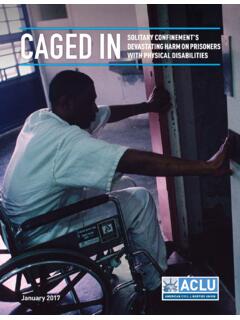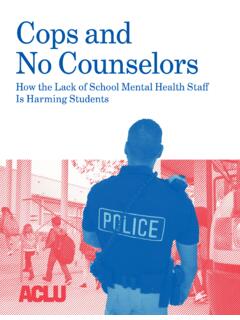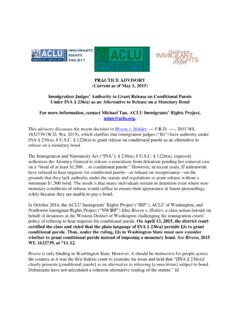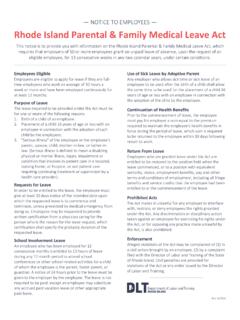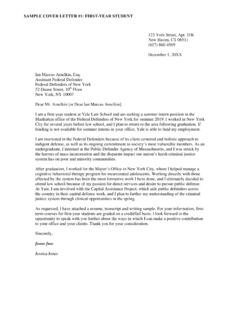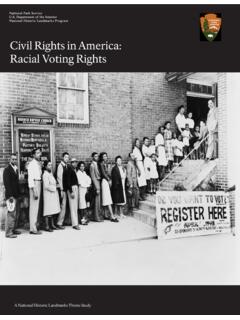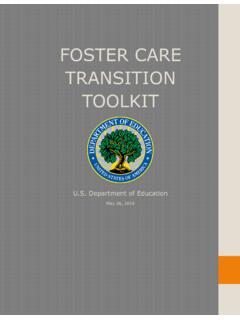Transcription of Domestic Violence and Homelessness
1 Domestic Violence and Homelessness When women flee Domestic abuse, they are often forced to leave their homes, with nowhere else to turn. Landlords also sometimes turn victims of Domestic Violence out of their homes because of the vio- lence against them. For years, advocates have known that Domestic Violence is a primary cause of Homelessness for women and families. Studies from across the country confirm the connection between Domestic Violence and Homelessness and suggest ways to end the cycle in which Violence against women leads to life on the streets. Trapped Between Violence and control over their partners and isolate their tims know that they may face eviction if a Homelessness partners from support networks. As a landlord finds out about the abuse, they result, a woman who has experienced are less likely to seek this assistance and Housing instability and a lack of safe and Domestic Violence will often have little or more likely to submit to the abuse.
2 Affordable housing options heightens the no access to money and very few friends risks for women experiencing Domestic or family members to rely on if she flees a Domestic Violence and Poverty Violence : violent relationship. Poor women, who are more vulnerable to A lack of alternative housing often leads Homelessness , are also at greater risk of Many landlords have adopted policies, women to stay in or return to violent rela- Domestic Violence . Poverty limits women's such as zero tolerance for crime policies, tionships. In Minnesota in 2003, for instance, choices and makes it harder for them to that penalize victims of Domestic Violence . 46 percent of homeless women reported escape violent relationships. For instance: These policies allow landlords to evict ten- that they had previously stayed in abusive ants when Violence occurs in their homes, relationships because they had nowhere to While women at all income levels experi- regardless of whether the tenant is the vic- In 2003, in Fargo, North Dakota, 44 per- ence Domestic Violence , poor women expe- tim or the perpetrator of the Violence .
3 A. cent of homeless women reported that rience Domestic Violence at higher rates Michigan study of women currently or for- they stayed in an abusive relationship at than women with higher household merly receiving welfare found that women some point in the past two years because incomes. Women with household incomes who had experienced recent or ongoing they did not have other housing options. 2. of less than $7,500 are 7 times as likely as Domestic Violence were far more likely to women with household incomes over face eviction than other Abusers typically use Violence as part of $75,000 to experience Domestic larger strategies to exercise power and Some landlords are unwilling to rent to a Women living in rental housing experience woman who has experienced Domestic vio- intimate partner Violence at three times the lence.
4 For example, a 2005 investigation by rate of women who own their A 2003 survey of homeless a fair housing group in New York City found that 28 percent of housing providers either mothers around the country flatly refused to rent to a Domestic Violence Women living in poor neighborhoods are more likely to be the victims of Domestic victim or failed to follow up as promised found that one quarter had Violence than women in more affluent when contacted by an investigator posing neighborhoods. Indeed, women in finan- been physically abused in as a housing coordinator for a Domestic vio- cially distressed couples who live in a poor lence survivor assistance the past year . neighborhoods are twice as likely to be vic- tims of Domestic Violence than women in Landlords often only learn about domes- equally financially distressed relationships MORE FACTS INSIDE tic Violence because victims have sought living in more affluent neighborhoods.
5 7. the help of police or the courts. When vic- MAP: Facts on Ho In Fargo, North Dakota, in 2003, 1 in 5 home- less women reported that she had left her home to flee abuse. In Fargo, 45 percent of homeless women had experienced Violence from an intimate partner in the past year. 8. In 2005, 50 percent of cities surveyed reported that Domestic Violence is a primary cause of Homelessness . In 2005 in Iowa, nearly a qu less households in the state were homeless because of Homeless service providers ily break-up/divorce was th factor leading to homeles Domestic Violence specifica top five factors leading to ho In San Diego, almost 50 percent of homeless women are Domestic Violence victims. In fact, this number may actually be much higher, due to women's reluctance to report Domestic vio- lence because of shame or fear of t Homelessness Facts In 2005, 50 percent of cities surveyed under five have witnessed Domestic Violence in reported that Domestic Violence is a primary their families, according to a 1999 cause of Homelessness .
6 These cities included Burlington, Cedar Rapids, Charleston, Chicago, A 1997 survey of homeless parents in ten Los Angeles, Nashville, Philadelphia, St. Paul, cities around the country found that 22 percent Salt Lake City, San Antonio, Seattle, and had left their last residence because of domes- tic Violence . Among parents who had lived with A 2003 survey of homeless mothers around a spouse or partner, 57 percent of homeless the country found that one quarter had been parents had left their last residence because physically abused in the past year and almost of Domestic all had experienced or witnessed Domestic vio- lence over their According to a 1990 study, half of all home- less women and children are fleeing Forty-seven percent of homeless school-aged children and 29 percent of homeless children omelessness in the United States A study of family Homelessness in Massachusetts In Minnesota.
7 1 in every 3 homeless women found that 92 percent of homeless women had t was driven from her home by Domestic vio- experienced severe physical and/or sexual lence in assault at some time in their lives. One third of u homeless women were current or recent vic- tims of Domestic Violence . 20. A Michigan survey of homeless adults in 1995. t t found that physical abuse was most frequently cited as the main cause of t t t uarter of all home- In New York City, almost half of all homeless e reported that they In 2003 in Chicago, 56 percent of women in parents had been abused and one quarter of f Domestic Violence . homeless shelters reported they had been all homeless parents were homeless as a s reported that fam- victims of Domestic Violence and 22 percent direct result of Domestic Violence in he most significant stated that Domestic Violence was the imme- t ssness in Iowa and diate cause of their ally was among the In Virginia, shelters reported in 1995 that 35.
8 Percent of those receiving shelter were t homeless because of family In Missouri, 27 percent of individuals in home- less shelters were survivors of Domestic vio- t lence in 2001, making Domestic Violence a primary cause of Homelessness in the A 2000 survey of parents living in homeless shel- ters with their children in Kentucky, Tennessee, and the Carolinas found that two-thirds of homeless parents had experienced Domestic A 2003 Florida study found that 46 percent of Domestic Violence survivors reported that they had experienced Homelessness as a result of the Violence . Eighty-three percent of survivors reported they had difficulty finding suitable and affordable t Protecting Battered Women's Homes Some states, most notably Washington, in certain circumstances.
9 Some states, for rhode Island, and North Carolina, have instance, only prohibit evicting those victims One way to reduce the risk of Homelessness adopted broader laws specifically prohibiting of Domestic Violence who have obtained for Domestic Violence victims is to protect housing discrimination against Domestic vio- restraining orders against their abusers. them from housing discrimination on the lence Most states, however, either While states are moving in the right direc- basis of Domestic Violence . For this reason, have no laws at all explicitly protecting tion, these kinds of technicalities limit many the American Bar Association has urged Domestic Violence victims' housing rights or state laws' effectiveness in reducing domes- lawmakers to prohibit this form of discrimi- have laws that offer only narrow protection tic Violence and subsequent Homelessness .
10 Nation. As the report accompanying the ABA's recommendation explained, Until we stop asking women to choose between being beaten and being able to feed and What to Do shelter their children, we cannot expect to rid our society of Domestic Violence . 25. In 2005, a federal law was adopted prohibit- If you are being abused and need immediate assistance, call the National Domestic Violence Hotline at (800) 799-SAFE. ing many kinds of discrimination against victims of Domestic Violence who live in If you feel you have been discriminated against in housing because public housing or Section 8 This you are have experienced Domestic Violence , call the ACLU Women's law states, for instance, that being a victim Rights Project at (212) 549-2644 or email of Domestic Violence is not alone a reason for eviction from public housing or loss of a To learn more about laws and policies that can protect Domestic vio- housing voucher.

